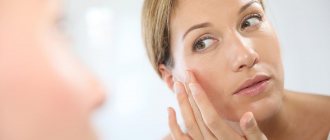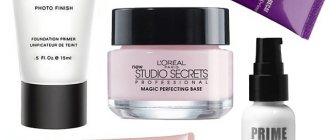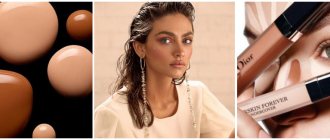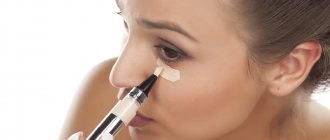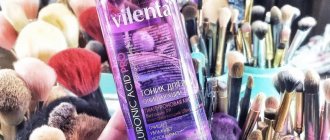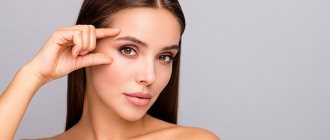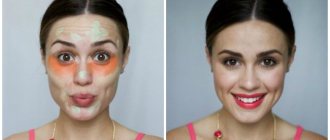Home » Face
Category: Face
Ladies, what is the most important makeup product you have in your makeup bag? For many of us, this is a magical, irreplaceable invention called a corrector. Even on days when we don't sleep, we can fake a good night's rest with a little bit of it here and there. Once you apply concealer to some key areas of your face, your skin will instantly look better without needing coverage elsewhere. If you want to keep your makeup minimal, then concealer is exactly what you need! We are going to give some essential pointers on how to apply concealer correctly and also how you can use it as your base for your makeup.
- Why do you need a face corrector?
- Why do you need a green face concealer?
- Colors of correctors for the face: which one for what
- How to choose a face corrector?
- How to properly apply concealer to your face
- How to use a face corrector pencil: step-by-step photos
- How to use a palette of color correctors for the face: step-by-step instructions with video
- How to use liquid face concealer
- The best color corrector palettes for the face
- The best spot correctors for the face
Why do you need a face corrector?
First, the texture of your concealer is just as important as its shade. Secondly, you will need more than one type of concealer to achieve the right color. The product you use to cover your dark circles is not the same as what you use to cover up your dark spots. The area under your eyes will have some sort of purple color to it, and to combat this means using a concealer that has orange or peach tones to it.
To conceal a blemish or dark spots, use a heavier formula (that matches the shade of your foundation), and if there is redness in the blemish, applying a green concealer will help neutralize that area.
Do you apply foundation or foundation before or after concealer? Remember that if you are going to apply foundation, it is best to apply foundation all over before applying concealer as it helps cover up a lot of imperfections on its own.
Why do you need a green face concealer?
Green is the opposite color of red on the color wheel and is therefore the strongest color for canceling out red. Because of this, green color-correcting concealers are best for neutralizing intense red spots. Most green color correctors are a pastel mint color.
- Use green concealers directly on small red areas such as pimples.
- Green concealers are also good for moderate areas of redness such as mild acne and irritation. For those with fair skin, apply green concealer down the front of the nose, center of the forehead, around the nostrils and along the cheekbones.
- For more diffuse areas of bright redness that cover most of your face, such as sunburn or rosacea, consider using a green-colored primer instead. A tinted foundation will work just like a color correcting concealer but will even out your tone for a flawless foundation application.
Colors of correctors for the face: which one for what
Here are the main colors you'll find and what they address:
- Green color: redness and broken capillaries
- Blue/lavender: dark circles
- Pink/Peach: Darkness, dullness and blue veins, especially on fair skin
- Yellow: Dull, especially in olive skin tones
- Orange/Red: Darkness on skin tones deeper than medium
There are different rules for under eye circles when it comes to light/medium and dark skin tones. For fair skin, a yellow, peach or purple based corrector will undo the gray tones created when the corrector was used over shadow areas.
On darker skin, use a bright orange or red color first, followed by a neutral or yellow tinted concealer. In any case, apply the concealer with your finger or brush to prevent it from smearing.
Yellow color corrector
Add a layer of yellow to even out your ruddy complexion.
Sometimes green concealers work too well, leaving your skin looking dull and lifeless. By choosing yellow instead, a warm color next to green on the color wheel, you can soften the red discoloration without completely removing all traces.
- Yellow concealers are a good choice for covering mild to moderate diffuse redness.
- Yellow concealers are also great for neutralizing and brightening dark purple and blue marks such as fresh bruises, age spots, sun spots and dark circles under the eyes in some people.
- Many concealers and foundations for lighter skin tones have some degree of yellow pigment for built-in color correction.
Orange color corrector
Use bright orange on darker skin tones. If you have darker skin, orange can be used for different types of discoloration, from acne scars to hyperpigmentation around the lips.
- You can also apply orange all over your face for a glowing effect. When using orange as a full face product, consider using a dusting of orange powder or tinted foundation instead of concealer.
- Orange is also the color of choice for correcting blue tinted under eye circles on medium to dark skin.
- If you have darker skin that has a lot of natural variation in tone, it's best to also use two or more different orange colors for color correction. Use a deeper orange on darker areas of the skin and a paler orange on lighter areas.
- If you have fairer skin, then you may choose to use orange concealer as a bronzer for contouring instead of color correction. Orange is generally too bold to work as a color corrector on fair skin, but you can brighten your under-eye area with a subtle salmon color corrector.
Lip correction
In this matter, you may have several goals, and for each of them there is a special method.
- Visual increase. To visually enlarge your lips, you need to take a little concealer or light corrector without a shimmering substance in the composition. A thin white pencil is ideal for this task; otherwise, you can use a thin brush. Use a light or nude cosmetic product to outline the outline. Next, you can apply lipstick or gloss on top of this, slightly going beyond the edges and creating the desired shape. You can also take a darker color and use it to paint perfect lips.
- Adding sensuality and relief. Many videos on how to contour your face include lessons on how to highlight your lips. To give them a plump and sultry look, you need to put a little emphasis on the top “bow” using a highlighter. This is done with a brush, sponge or (in the absence of these) with a fingertip. Finally, you can give your lips some color, but you can also leave them natural.
After designing this area, the contour can be outlined with light powder: this way it will appear more even.
How to choose a face corrector?
Understand how color correctors and concealers work.
Color-correcting concealers help disguise skin discoloration, giving problem areas a more neutral tone. When choosing concealers, understanding color theory will be helpful.
- Complementary colors are colors that are completely opposite of each other on the color wheel. Below are the basic complementary color pairs you'll use for color correction: red with green, yellow with violet, and blue with orange.
- For most types of color correction, makeup in one color will cancel out the bleaching of its complement.
- A completely opposite color can also sometimes appear lifeless and unnatural. In these cases, you should use color next to the bleach addition.
- Most corrective concealers come in one shade. The exceptions are orange and beige. To do this, choose deeper shades if you have a darker skin tone and pastel shades if you have a lighter skin tone.
- Regular skin tone corrector is usually used on top of color correctors.
How to properly apply concealer to your face
Here are a bunch of tips and hacks that will come in handy when you're applying concealer. Also, take a look at how to use concealer to enhance your makeup look. Let's get a look!
- First the foundation and then the concealer. If you are using foundation, apply it first so you don't have to cover up much. Plus, if you apply concealer first, you'll remove most of it while applying foundation.
- Never skimp on quality when it comes to concealer. Invest in a good product that will apply smoother and be less likely to dry out and bake.
- To prevent your eyeshadow from falling out and fading, use your concealer to set the eyeshadow first.
- Use a peach tinted concealer for blue or purple circles under the eyes. Use a yellow tinted concealer to even out your skin tone. And use green corrector for red spots.
- If you want to prevent your concealer from creasing around your eyes, blot the area with a tissue after applying to prevent it from settling in the creases around your eyes.
- You can also use concealer as a base to brighten your lipstick shade.
- To prevent your lip color from smearing, line your lips with concealer using the fine tip of the brush. Your lips will also look extra defined after this one simple step!
What to shade with?
Many people wonder what is the best way to apply concealer to their face. This, like shading, can be done in several ways.
- Some people find it more convenient to use their fingertips without purchasing additional tools.
- Using a brush is a more hygienic method. It can be used to work in more detail on some hard-to-reach areas such as the wings of the nose, or it can be used specifically on problem areas.
- For this procedure, you can use the pointed tip of a sponge . It is recommended to take a damp cosmetic sponge to make the coating more natural. Apply cosmetics using blotting rather than rubbing movements.
- Some products have a special applicator for easy application.
How to use a face corrector pencil: step-by-step photos
Step 1: Prepare your skin
Always start with a clean face! Cleanse, exfoliate and moisturize your skin with a facial moisturizer, apply some foundation, and then move on to makeup.
Step 2: Conceal Dark Circles Around Your Eyes
How to apply concealer under the eyes? Use a concealer that is no more than two shades lighter than your natural skin tone. What you should do is brighten the area under the eye by creating two inverted triangles and blending them using a brush or beauty sponge.
Step 3: Conceal the redness around your nose
If you have any redness or discoloration around your nose, the best way to apply concealer is to take a small amount and mix it thoroughly.
Step 4: Conceal Dark Spots
If you have acne scars or blemishes, layering on tons of foundation is not the solution. Use a small concealer brush and apply the product to blemishes over problem areas, blending it into the skin.
Step 5. Secure the corrector
It is best to set the concealer using powder as this will prevent the product from shifting. Take some powder onto a sponge and gently pat it into the areas where you applied your concealer. For the rest of your face, use a brush and gently apply powder everywhere for a natural look.
This is what happened
Application errors
There are several reasons why the use of such products becomes useless.
- Painting only under the eyelid, without covering the area in the inner corner of the eye. You need to distribute the product from the bridge of your nose to your temple in the form of an inverted triangle.
- Creating a layer with cold hands. It will be easier to apply makeup if your fingers are warmed up. But it is better to use brushes or sponges for these purposes.
- Incorrect acne camouflage. A dot of cream is applied to the inflammation itself and only the borders are smoothed out, not the part above the acne.
How to use a palette of color correctors for the face: step-by-step instructions with video
Concealing dark circles under the eyes with concealer
Apply peach or orange to dark circles under your eyes.
Concealers in this color family are a muted combination of orange, red, and yellow. Because of this, one concealer can cancel out the blues, greens, and purples often found in the dark under eye circles of people with fair to medium skin.
- In general, salmon works best on pale skin, while peach works best on olive and tanned skin.
- You may have to experiment a bit to find the exact shade that works best for your skin.
- Peach can also work very well on pale skin to correct brown spots and age spots.
- These shades are also good as an all-around balancing brightener for olive skin.
Even out skin tone with corrector
Apply lavender concealer to balance out yellow tones or yellow skin. Purple is a complement to yellow, so purple concealers neutralize warm yellow tones. The vast majority of purple concealers are pastel lavender in color.
- You can use lavender to cover up old bruises and age spots.
- Like orange and yellow, lavender can also be used anywhere. When using a color corrector in this manner, consider a tinted primer as an alternative.
- If your natural, healthy tone is yellow, don't feel the need to “fix” it. Skin that simply has a warm undertone appears radiant on its own.
Removing pigment spots using a corrector
Apply blue to cover up orange hyperpigmentation. While orange discoloration is uncommon, the best way to neutralize it is with its complement, which is blue. Most blue concealers tend to work best on fair to medium skin tones.
- These concealers are best for balancing warm tones that are dark and intense, such as sunspots.
- These concealers are also a good choice if you've gone a little overboard with DIY application.
- If the discoloration is all over your face, try using a blue foundation shade instead of a concealer.
Selection of cosmetics according to skin types
No matter how expensive the beauty products you buy, they won't be of any use if they don't suit you. Some of them fit perfectly on one type, but slide off on another and just look disgusting. The dermis, which is characterized by normal subcutaneous fat secretion, generally responds well to all textures. What to do for people with other disabilities will be described below.
Oily skin
This material has repeatedly spoken about the importance of selecting suitable skincare products. Contrary to all prejudices, girls with an increased amount of sebaceous secretions on the skin should not dry out the epidermis at all
All you need to do is choose the right palette. So, cleansing should be done with foams, and moisturizing with a cream that provides a mattifying effect. You can choose powder over foundation, or dust it on top. As for contouring tools, in this case it is better to give preference to dry textures. You can choose bronzer or loose pigment. It is important that all cosmetics create a mattifying effect. Liquid and cream textures may bleed or add undue shine. We also recommend using highlighter carefully. To avoid the “oil pancake” effect, apply it only to the tip of the nose and the corners of the eyes.
Dry
Hydration! This is the main thing in caring for this type. For washing, it is better to choose a special oil or gentle milk. There probably won’t be any issues with cream: it’s better to choose something very fatty and nutritious. All cream textures, from standard “foundation” to BB creams, are suitable as a foundation. Powder in these conditions will not be entirely appropriate. The corrector palette should contain gel or liquid cosmetic products. By choosing something nourishing and oily for yourself, you will restore balance, because of this, your entire skin will look healthy and beautiful.
Of course, all these recommendations are individual. If necessary, it is better to discuss some points with a dermatologist or cosmetologist.
How to use liquid face concealer
You can use your concealer as a base thanks to its versatility! So if you forgot to stock up on foundation, don't panic! Here's how to apply concealer and use it to create your base.
- Choose a formula you like, whether it's a cream or liquid concealer. Make sure you have two shades - one that matches your skin tone and one to brighten key areas of your face.
- Use a stippling brush because these brushes don't pick up too much product and you don't want your face to look made up and sticking out.
- Dip it into your concealer and start applying from under your eye area. Now you conceal and apply your foundation at the same time.
- Make sure you have an even amount of product and color all over your face and blend it thoroughly.
- Once you are done with this, use a little powder and use a brush to apply it to all the desired areas
- Now that your base is ready, you can use additional products like blush or bronzer and finish the look!
Types of concealers and features of their use
There are several types of facial concealers. They are used for different purposes and differ in the method of application.
Pencil
Concealer pencil is used on the face in spots to disguise minor problems, such as pimples or freckles. Quite dry in texture, it is perfect for skin with excessive sebaceous gland activity. These pencils often contain antibacterial additives that relieve symptoms of inflammation.
Palette
A set of concealers of different shades is convenient to use when you need to cover up several different problem areas or do contouring. It presents several desired shades at once. Step-by-step photos will show you how to use the palette for one purpose or another.
Creamy texture
The creamy product has a medium density and is great for covering dark spots in the under-eye area. It is easier to use to correct a large surface of the skin. An applicator or sponge is used for distribution. However, this option is not very suitable for those with oily skin, because the makeup may run.
STICK
Concealer sticks have a thicker texture and are perfect for skin with acne, red spots and other imperfections. They will help where products with a lighter structure fail. They apply well, but do not blend well and are not very suitable for spot application.
Liquid
The lightweight liquid concealer absorbs well and blends evenly. It is best used in the eye area or for age spots. It will give your face a healthy and fresh look. But it is better to apply a thin layer and remove excess with a napkin.
Dry
The crumbly structure of the dry concealer allows you to remove oily shine and disguise small spots and pimples. But if the skin is peeling, it will clearly emphasize this flaw. Therefore, it should be used only after pre-moistening. Indispensable for those with oily skin.
Check out a selection of the best products costing up to 500 rubles.
The best color corrector palettes for the face
Tarte Wipeout Color-Correcting Palette
This versatile palette from Tarte Cosmetics is the perfect choice for beginners. You can use its six shades to combat discoloration and contouring, as well as balance and brighten your skin tone. Simply apply the cream wherever you need it using a stiff brush until it blends into your skin.
Color correcting palette Stila Correct & Perfect B
This stunning palette from Stila is sure to win your heart with the way it looks and performs! It consists of five velvety-smooth cream concealers and two tinted setting powders. Light creams offer buildable coverage, while powders allow you to customize your coverage. Their rich formula contains vitamins A, C, E and Arclay Youth Revival mineral complex to reduce the appearance of pores and fine lines.
pros
- Easy
- Doesn't make your skin oily
- Waterproof
- Easy to use
MAKEOVER Pro Conceal And Correct Palette, shade F2302 (creative concealer)
Makeup artists swear by this professional color correcting palette from MAC, and yes, it's one of the best out there! Each palette consists of four concealers and two shade correctors in the middle depth of the color spectrum. Its formula is enriched with antioxidants and is suitable for all skin types. You can use the colors either individually or mix them to match your skin tone. She covers everything from spots to moles to tattoos! This palette comes in four different shade options: light, medium, medium-deep, and dark.
pros
- Doesn't roll down
- Many colors
- Dermatologist tested
- Non-acnegenic
Nyx color correction palette
This cult classic from NYX is one of the best color correcting palettes out there. It contains six creamy shades that can be mixed to create the perfect shade for you. Its formula is super-light, glides on easily and leaves your skin looking smooth, soft and supple. If you're new to color correction, this is a product you need to try!
pros
- Pigmented shades
- Easy
- Suitable for all skin types
- Accessible
Limoni Face corrector set Skin Perfect corrector 5 cells, shade 01
Want an Insta-perfect face? This color correcting kit from Maybelline corrects, conceals and highlights all in one palette. It's incredibly easy to use and a must-try for beginners! It works well on all skin types, and if affordability is a factor for you, it does a good job at a very decent price.
pros
- Easy to use
- Mixes easily
- Inexpensive
The best spot correctors for the face
L'Oréal Paris True Match Concealer
There is a perfect match for every skin tone due to the range of shades. It can be used sparingly for very light application or built up for more coverage if desired. I like to use neutral concealer colors to correct purple and blue circles and cool concealer to set and fade spots around the nose.
Neutrogena Perfector
This is a great alternative to its more expensive counterparts, such as the YSL Touche Éclat. It's a beautiful light texture that instantly covers dark circles and brightens under eyes. You can also use it under your eyeshadow to set it. Just make sure you use it sparingly.
L'Oreal Paris Alliance Perfect True Match Cream Concealer, shade 3-5N, natural beige
This is my favorite because not only does it provide great lighting, but it is also very easy to use. The pencil makes it easy to place concealer just where you need it. Plus, the range of colors is incredibly natural and wearable.
